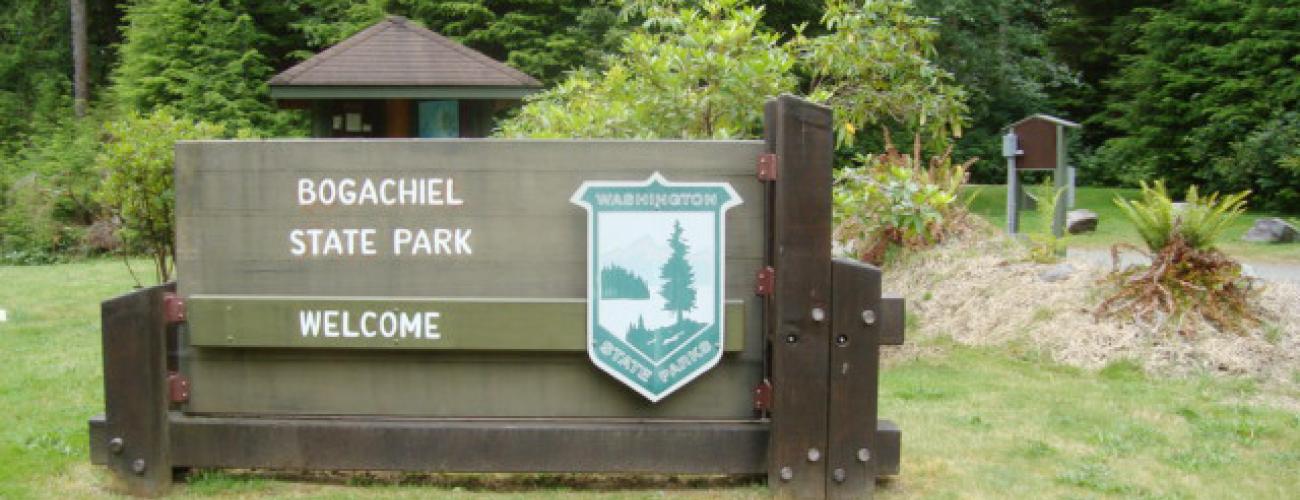Bogachiel State Park History
A Rain-fed River Runs Through It
Bogachiel State Park hugs the bank of the Bogachiel River (locally known as the “Bogie”) on the northwestern reaches of the Olympic Peninsula, providing recreational opportunities on the windward slope of the Olympic Mountains. Storms and moisture rise as they are forced up over the Olympic Mountains from the Pacific Ocean. When the moist air rises, it expands and cools. The colder air is less able to hold moisture, so clouds and precipitation form. Bogachiel State Park averages over 120 inches of annual precipitation!
Most of the rain falls in the fall and winter, and accounts for wide swings in the quantity of water flowing in the Bogachiel River, which gets no glacial meltwater from its headwaters in the lower elevations of the Olympic Mountains.
Steelhead and Moss
As water levels rise in November, Steelhead (Oncorhynchus mykiss irideus) begin to return to the Bogachiel River to spawn. Steelhead are an anadromous (live in both freshwater and saltwater at various life stages) type of rainbow trout. Many factors influence the timing and quantity of runs, but fishers at Bogachiel State Park generally find peak conditions in January and February.
Steelhead, unlike salmon species, are capable of returning to the ocean after spawning, to repeat the cycle. Spawned steelhead that successfully return to the ocean are termed “kelts.” Interestingly, the more time they spend in freshwater, the more their coloration resembles their relatives, the freshwater-only rainbow trout.
The abundant precipitation at Bogachiel State Park also benefits non-vascular plants, those that lack tubes in their structure to transport water from roots to leaves. Mosses are the most prominent non-vascular plants in the park, and their abundant rich green hues are dependent on copious rainfall to provide moisture and nutrients directly through absorption into their leaves.
Indigenous Land
Bogachiel State Park lies within the traditional territory of Indigenous people whose present-day descendants include members of the Quileute Tribe and the Hoh Indian Tribe. Like other northwest coast Indigenous people, their cultures feature expertly carved cedar canoes, shredded cedar bark clothing and cedar plank longhouses. The Quileute and Hoh are unique among the federally recognized tribes of Washington in that the Quileute language they share is not linguistically related to any other language in the world.
The Bogachiel River takes its name from a Quileute language word meaning “muddy water,” distinguishing it from the nearby Sol Duc (“sparkling water”). These two rivers join to form the Quileute River, which empties into the Pacific Ocean at the site of the main Quileute winter village, today’s La Push.
Local tribes ceded ownership of the area to the US federal government under duress in the Treaty of Olympia on January 25, 1856, keeping rights to harvest natural resources in their usual and accustomed places, including the watershed of the Bogachiel River.
Survey and Grant to the State of Washington
Government surveys of the area were completed in 1893, and the land in today’s Bogachiel State Park was granted to the State of Washington in 1895 to fulfill the terms promised to Washington State at statehood in 1889. The Enabling Act creating Washington State granted millions of acres of lands to the new state to be held in trust “for all of the people” to provide financial support for public schools and other state institutions.
Making a Park
On March 19,1931, Governor Roland H. Hartley approved Senate Bill 88, providing that the "Commissioner of Public Lands is hereby authorized and directed to reserve from sale certain public lands for park purposes” referring to the legal description of today’s Bogachiel State Park. The governor also vetoed all funding for the operation of the state parks, blocking development of the park for public use.
The State Parks Committee entered into an agreement with the Bogachiel Commercial Club and the Forks Chamber of Commerce to jointly operate and manage the park. Subsequently, owners of the nearby Bogachiel Resort maintained and operated the park until 1958.
The Washington State Parks and Recreation Commission (WSPRC) began staffing the park after formalizing the lease to the WSPRC from Commissioner of Public Lands Bert C. Cole on July 6, 1961.
In 1971 the Washington State Legislature decided that continued lease of trust lands for park purposes was not in the best interest of the state and directed the Department of Natural Resources (DNR) and the WSPRC to negotiate a sale of the leased lands. The two agencies entered into a contract for the purchase of 15,083 acres in 24 parks, including 119 acres in Bogachiel State Park, at a total purchase price of $11.4 million. However, the timber on the lands was excluded from the contract, as there was no source of funding. The timber in Bogachiel State Park alone was appraised to be more than 3.3 million board feet valued at $946,000. In 1980, the legislature authorized the sale of bonds to cover the cost of the timber; on October 7, 1992, it was deeded to the WSPRC, securing its permanent protection.
Sharing the histories of Washington’s state parks is an ongoing project. Learn more here.

